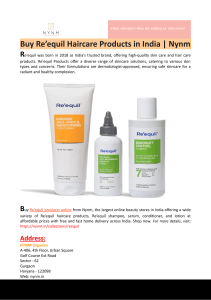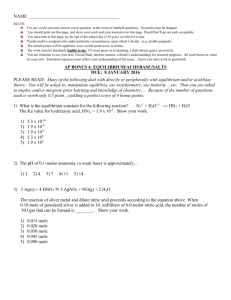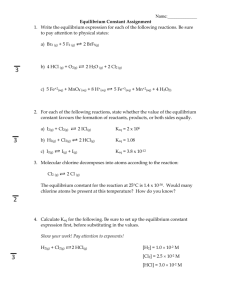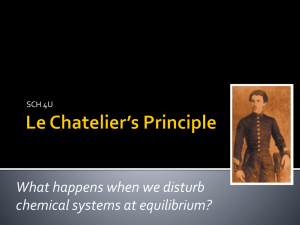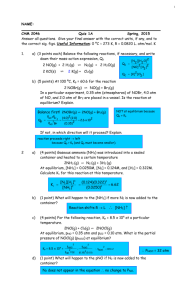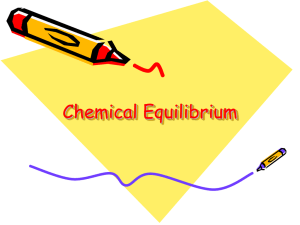File
advertisement
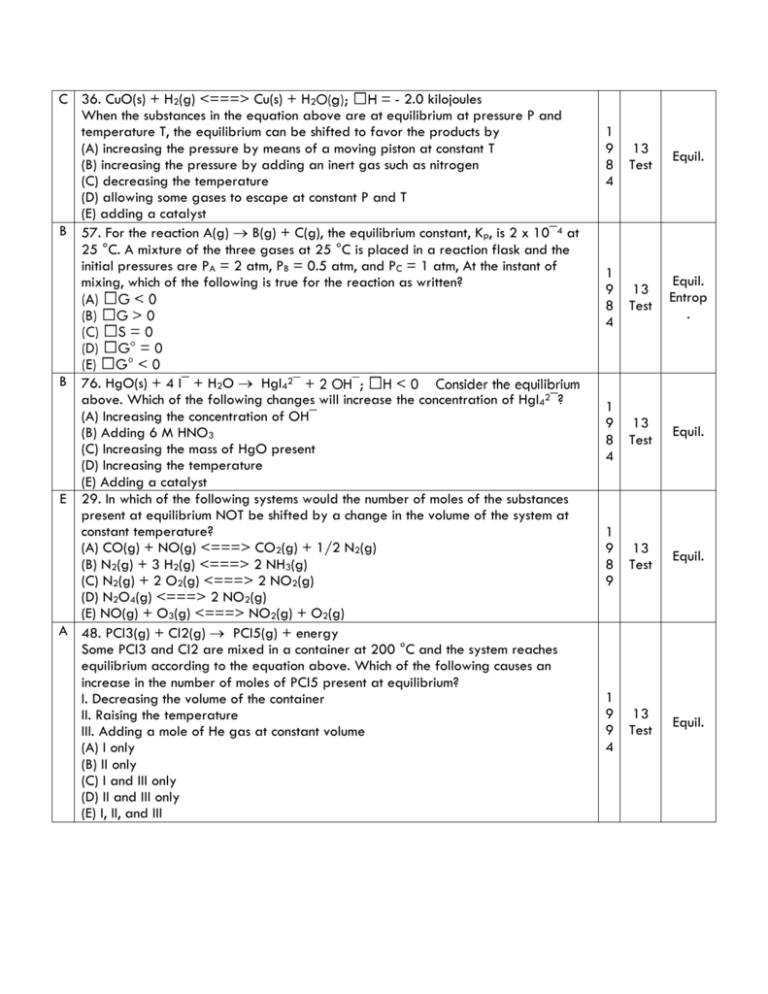
C 36. CuO(s) + H2(g) <===> Cu(s) + H2 - 2.0 kilojoules When the substances in the equation above are at equilibrium at pressure P and temperature T, the equilibrium can be shifted to favor the products by (A) increasing the pressure by means of a moving piston at constant T (B) increasing the pressure by adding an inert gas such as nitrogen (C) decreasing the temperature (D) allowing some gases to escape at constant P and T (E) adding a catalyst B 57. For the reaction A(g) B(g) + C(g), the equilibrium constant, Kp, is 2 x 10¯4 at 25 °C. A mixture of the three gases at 25 °C is placed in a reaction flask and the initial pressures are PA = 2 atm, PB = 0.5 atm, and PC = 1 atm, At the instant of mixing, which of the following is true for the reaction as written? B 76. HgO(s) + 4 I¯ + H2O HgI42 above. Which of the following changes will increase the concentration of HgI42¯? (A) Increasing the concentration of OH¯ (B) Adding 6 M HNO3 (C) Increasing the mass of HgO present (D) Increasing the temperature (E) Adding a catalyst E 29. In which of the following systems would the number of moles of the substances present at equilibrium NOT be shifted by a change in the volume of the system at constant temperature? (A) CO(g) + NO(g) <===> CO2(g) + 1/2 N2(g) (B) N2(g) + 3 H2(g) <===> 2 NH3(g) (C) N2(g) + 2 O2(g) <===> 2 NO2(g) (D) N2O4(g) <===> 2 NO2(g) (E) NO(g) + O3(g) <===> NO2(g) + O2(g) A 48. PCl3(g) + Cl2(g) PCl5(g) + energy Some PCl3 and Cl2 are mixed in a container at 200 °C and the system reaches equilibrium according to the equation above. Which of the following causes an increase in the number of moles of PCl5 present at equilibrium? I. Decreasing the volume of the container II. Raising the temperature III. Adding a mole of He gas at constant volume (A) I only (B) II only (C) I and III only (D) II and III only (E) I, II, and III 1 9 8 4 13 Test Equil. 1 9 8 4 13 Test Equil. Entrop . 1 9 8 4 13 Test Equil. 1 9 8 9 13 Test Equil. 1 9 9 4 13 Test Equil. D 51. 4 HCl(g) + O2(g) 2 Cl2(g) + 2 H2O(g) Equal numbers of moles of HCl and O2 in a closed system are allowed to reach equilibrium as represented by the equation above. Which of the following must be true at equilibrium? I. [HCl] must be less than [Cl2]. II. [O2] must be greater than [HCl]. III. [Cl2] must equal [H2O]. (A) I only (B) II only (C) I and III only (D) II and III only (E) I, II, and III A 73 R. 2 SO2(g) + O2(g) 2 SO3(g) When 0.40 mole of SO3 and 0.60 mole of O2 are placed in an evacuated 1.00-liter flask, the reaction represented above occurs. After the reactants and the product reach equilibrium and the initial temperature is restored, the flask is found to contain 0.30 mole of S03. Based on these results, the expression for the equilibrium constant, Kc, of the reaction is (A) (0.30)2 / [(0.45)(0.10)2] (B) (0 30)2 / [(0.60)(0.40)2] (C) (2 x 0.30) / [(0.45)(2 x 0.10)] (D) (0.30) / [(0.45)(0.10)] (E) (0.30) / [(0.60)(0.40)] 54. 2NO(g) + O2(g) 2 NO2 0 Which of the following changes alone would cause a decrease in the value of Keq for the reaction represented above? B A) Decreasing the temperature B) Increasing the temperature C) Decreasing the volume of the reaction vessel D) Increasing the volume of the reaction vessel E) Adding a catalyst E 71. Which of the following reactions does NOT proceed significantly to the right in aqueous solutions? (A) H3O+ + OH¯ ---> 2 H2O (B) HCN + OH¯ ---> H2O + CN¯ (C) Cu(H2O)42+ + 4 NH3 ---> Cu(NH3)42+ + 4H2O (D) H2SO4 + H2O ---> H3O+ + HSO4¯ (E) H2O + HSO4¯ ---> H2SO4 + OH¯ B 54. Which of the following is the correct equilibrium expression for the hydrolysis of CO32¯ ? (A) K = [HCO3¯ ] / ( [CO32¯ ] [H3O+] ) (B) K = ( [HCO3¯] [OH¯] ) / [CO32¯] (C) K = ( [CO32¯ ] [OH¯] ) / [HCO3¯] (D) K = [CO32¯ ] / ( [CO2] [OH¯]2 ) (E) K = ( [CO32¯ ] [H3O+] ) / [HCO3¯] 1 9 9 4 13 Test Equil. 1 9 9 4 13 Test Equil. 1 9 9 9 13 Test Equil. 1 9 8 4 14 Aque. Equil. 1 9 8 9 14 Aque. Equil. D 74. How many moles of NaF must be dissolved in 1.00 liter of a saturated solution of PbF2 at 25 °C to reduce the [Pb2+] to 1 x 10¯6 molar? (Ksp of PbF2 at 25 °C = 4.0 x 10¯8) (A) 0.020 mole (B) 0.040 mole (C) 0.10 mole (D) 0.20 mole (E) 0.40 mole E 52. The test for the presence of Ag+ in an unknown solution involves the treatment of the solver-ammonia complex with dilute hydrochloric acid. The appearance of a white precipitate at this point indicates the presence of silver ion in the original sample. The net ionic equation that represents this test is (A) Ag(NH4)4+ + 4 H+ <===> Ag(s) + 4 NH4+ (B) Ag(NH4)4+ + Cl¯ <===> AgCl(s) + 4 NH4+ (C) Ag(NH3)4+ + 4 HCl <===> AgCl(s) + 4 NH4+ + 3 Cl#175; (D) Ag(NH3)4+ + Cl¯ <===> Ag(NH3)2Cl(s) (E) Ag(NH3)4+ + 2 H+ + Cl#175; <===> AgCl(s) + 2 NH4+ C 65. The solubility of CuI is 2 x 10¯6 molar. What is the solubility product constant, Ksp, for CuI? (A) 1.4 x 10¯3 (B) 2 x 10¯6 (C) 4 x 10¯12 (D) 2 x 10¯12 (E) 8 x 10¯18 D 66. MnS(s) + 2 H+ <===> Mn2+ + H2S(g) At 25 °C the solubility product constant, Ksp, for MnS in 5 x 10¯15 and the acid dissociation constants K1 and K2 for H2S are 1 x 10¯7 and 1 x 10¯13, respectively. What is the equilibrium constant for the reaction represented by the equation above at 25 °C? (A) 1 x 10¯13 / 5 x 10¯15 (B) 5 x 10¯15 / 1 x 10¯7 (C) 1 x 10¯7 / 5 x 10¯20 (D) 5 x 10¯15 / 1 x 10¯20 (E) 1 x 10¯20 / 5 x 10¯15 A 67. What is the molar solubility in water of Ag2CrO4? (The Ksp for Ag2CrO4 is 8 x 10¯12.) A) 8 x 10¯12 M B) 2 x 10¯12 M C) (4 x 10¯12 M)1/2 D) (4 x 10¯12 M)1/3 E) (2 x 10¯12 M)1/3 1 9 8 4 15 Ksp 1 9 8 9 15 Aque. Equil. 1 9 8 9 15 Ksp 1 9 8 9 15 Ksp 1 9 9 9 15 Ksp C 53. Which of the following must be true for a reaction that proceeds spontaneously from initial standard state conditions? (A) ∆G° > 0 and Keq > 1 (B) ∆G° > 0 and Keq < 1 (C) ∆G° < 0 and Keq > 1 (D) ∆G° < 0 and Keq > 1 (E) ∆G° = 0 and Keq = 1 E 70. H2O(s) ---> H2O(l) When ice melts at its normal melting point, 273.16 K and 1 atmosphere, which of the following is true for the process shown above? (A) ∆H < 0, ∆S > 0, ∆V > 0 (B) ∆H < 0, ∆S < 0, ∆V > 0 (C) ∆H > 0, ∆S < 0, ∆V < 0 (D) ∆H > 0, ∆S > 0, ∆V > 0 (E) ∆H > 0, ∆S > 0, ∆V < 0 1 9 8 9 16 Test Equil Therm 1 9 8 9 16 17 Equil Therm
